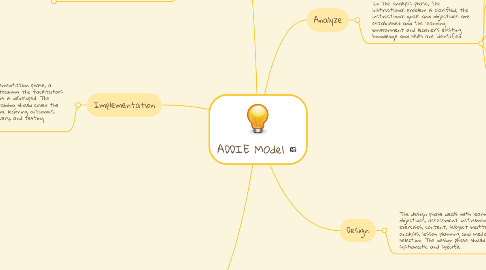
1. Analyze
1.1. In the analysis phase, the instructional problem is clarified, the instructional goals and objectives are established and the learning environment and learner's existing knowledge and skills are identified.
1.1.1. Who your learners are
1.1.2. What are the overall goals you are trying to achieve
1.1.3. What are the overall knowledge, skills, attitudes, and behaviors that need to be taught
1.1.4. What is the amount and level of content needed
1.1.5. What resources are required and available
2. Design
2.1. The design phase deals with learning objectives, assessment instruments, exercises, content, subject matter analysis, lesson planning and media selection. The design phase should be systematic and specific.
2.1.1. How will the content and activities be sequenced, presented and reinforced
2.1.2. What are the objectives of each session/unit
2.1.3. What skills or outcomes are you hoping to achieve for each
2.1.4. What methodology will you use to achieve each objective
2.1.5. What media/resources will be used in the instruction
2.1.6. How will you assess the students' understanding of the material
3. Development
3.1. The development phase is where instructional designers and developers create and assemble the content assets that were blueprinted in the design phase. In this phase, storyboards are created, content is written and graphics are designed. If elearning is involved, programmers work to develop and/or integrate technologies.
3.1.1. How do I create a lesson plan
3.1.2. How should the content be organized
3.1.3. What instructor and student activities should be included
3.1.4. How do I provide practice for students
3.1.5. What media should I use when teaching
3.1.6. How can I present confirming and corrective feedback
4. Evaluation
4.1. The evaluation phase plays an important role in the beginning and at the end of the process. Evaluation objectives reflect much of the discoveries found in the Analysis process. These discoveries include the objectives and expectations of the learner. When looking at the process, you must avoid the thought that it is structured in a chronological order. Rather, the ADDIE Model is a continuous circle with overlapping boundaries. Of all of the process phases, the evaluation phase is the lest understood.
4.1.1. How do I know if my course has been successful
4.1.2. Which experts should review the materials before a course is presented to students
4.1.3. Which changes should be made to improve the course after it is presented
5. Implementation
5.1. During the implementation phase, a procedure for training the facilitators and the learners is developed. The facilitators' training should cover the course curriculum, learning outcomes, method of delivery, and testing procedures.
5.1.1. How do I motivate students
5.1.2. How do I introduce the lesson
5.1.3. What kinds of questions are best to use
5.1.4. How do I use PowerPoint slides or other presentation media
5.1.5. How do I summarize and review each lesson or presentation
5.1.6. How do I use my time wisely during the lesson

